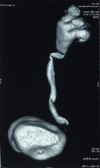Arteriovenous malformation of ureter presenting without hematuria: An unusual presentation of a rare disease
- PMID: 34194147
- PMCID: PMC8210726
- DOI: 10.4103/UA.UA_24_20
Arteriovenous malformation of ureter presenting without hematuria: An unusual presentation of a rare disease
Abstract
Genitourinary tract arteriovenous malformations are extremely rare. Most of the lesions are found either in the kidney or urinary bladder. So far, to the best of our knowledge, only five cases of arteriovenous malformation of the ureter have been reported in the literature. Here, we present, a young male, clinically presented with pain in the left flank with no other significant history. On radiological evaluation found to have left hydroureteronephrosis with stricture of the left distal ureter at the level of iliac vessel crossing. Urine routine, cytology, and cystoscopy were unremarkable. Left retrograde pyelogram showed distal ureteric stricture. Patient underwent excision of left distal ureteric stricture segment and ureteric reimplantation with psoas hitch. Histopathological examination revealed the features of arteriovenous malformation of the left ureter. The patient is asymptomatic and has no recurrence on follow-up until 12 weeks after surgery.
Keywords: Arteriovenous malformation; hematuria; ureteric reimplantation; ureteric stricture.
Copyright: © 2021 Urology Annals.
Conflict of interest statement
There are no conflicts of interest.
Figures




References
-
- Varela ME. Aneurisma arteriovenosa de los vasos renales yasistolia consecutiva. Rev Med Latino-Amer. 1928;14:3244.
-
- Kaplan SA, Brown W, Bixon R, O’Toole K, Benson MC. Arteriovenous malformation of the ureter. Urology. 1992;40:450. - PubMed
-
- Tang CN, Law IC, Iu PP, Yip AW. Arteriovenous malformation of the ureter–a rare cause of haematuria. Br J Urol. 1997;80:500–1. - PubMed
-
- Sech SM, Saboorian MH, Ashfaq R, Somerville PJ, Pearle MS. Polypoid arteriovenous malformation of the ureter. J Urol. 1997;158:1903–4. - PubMed
Publication types
LinkOut - more resources
Full Text Sources
